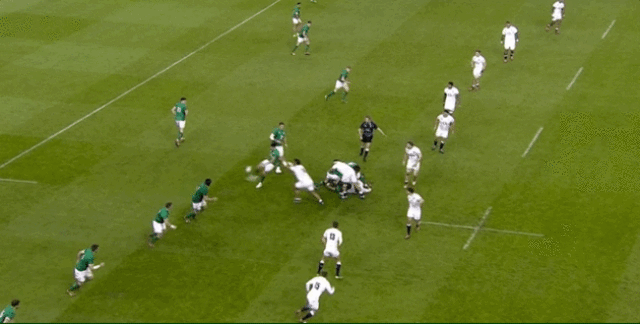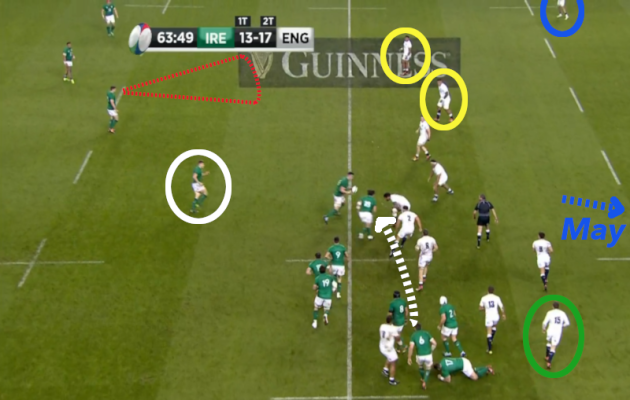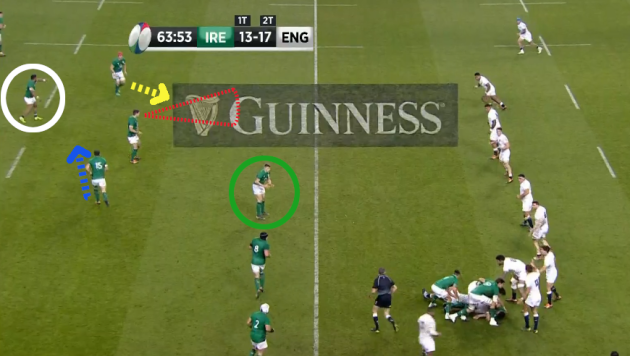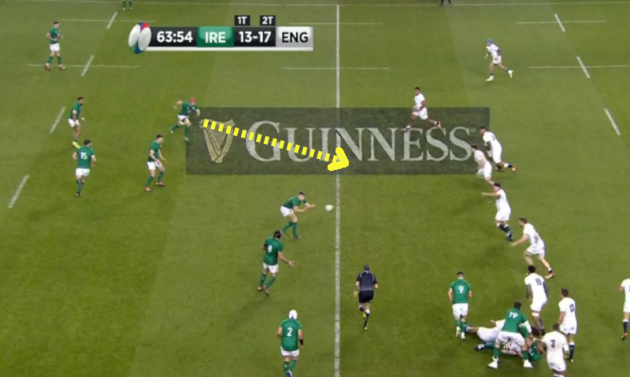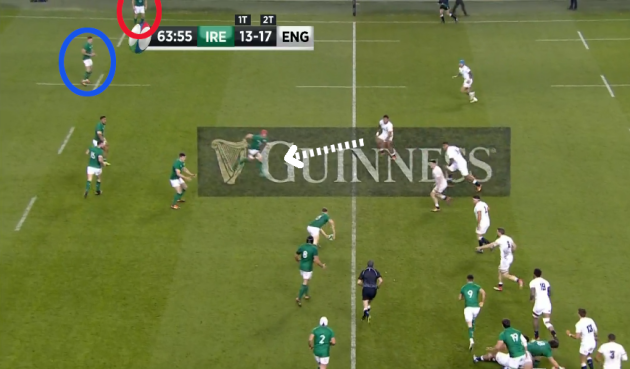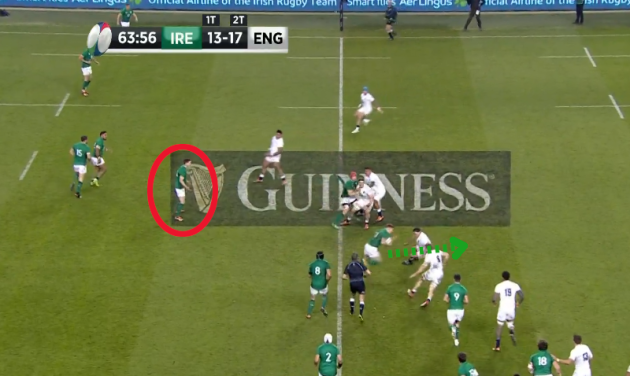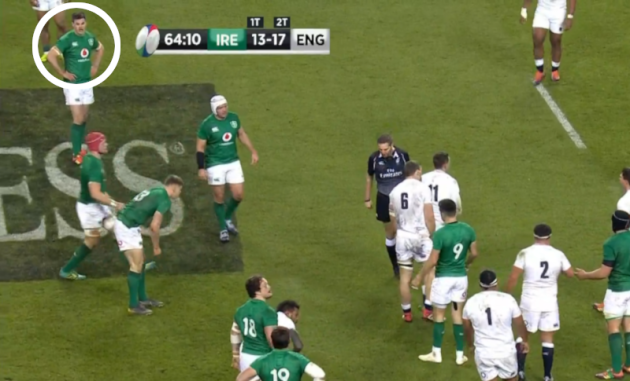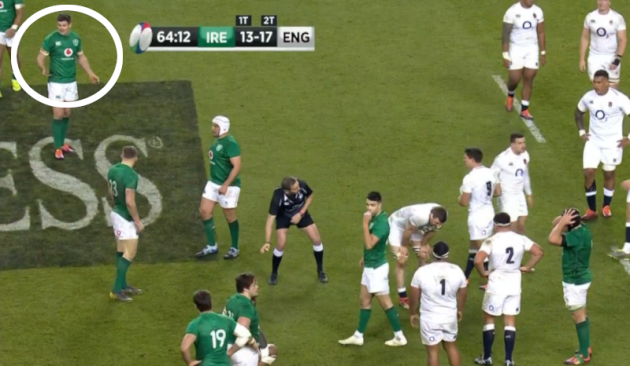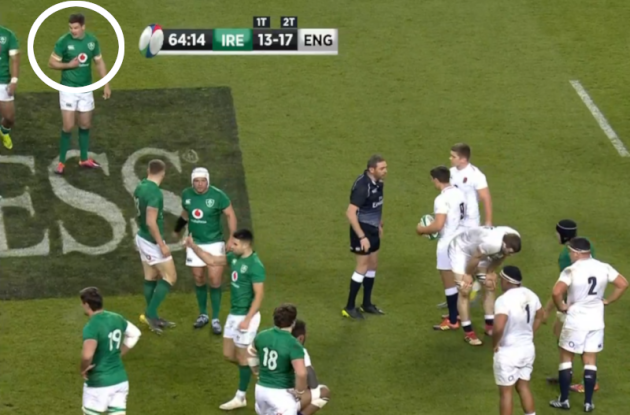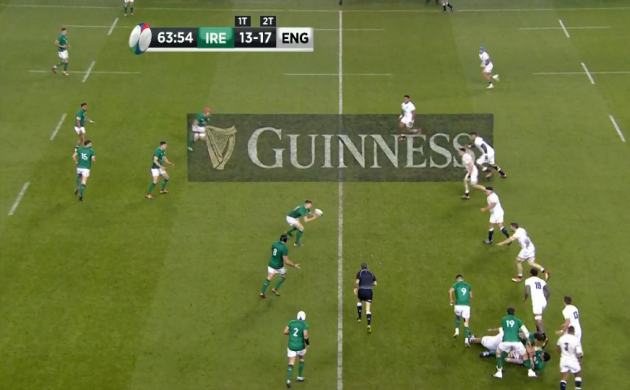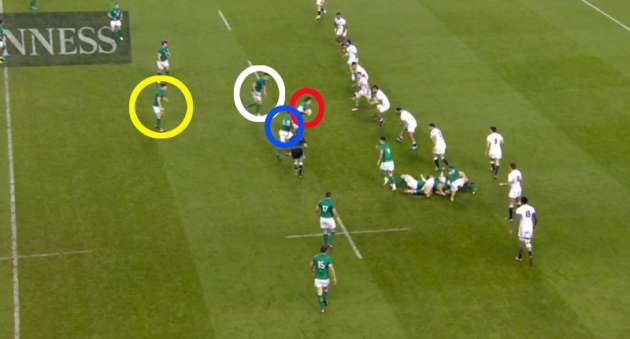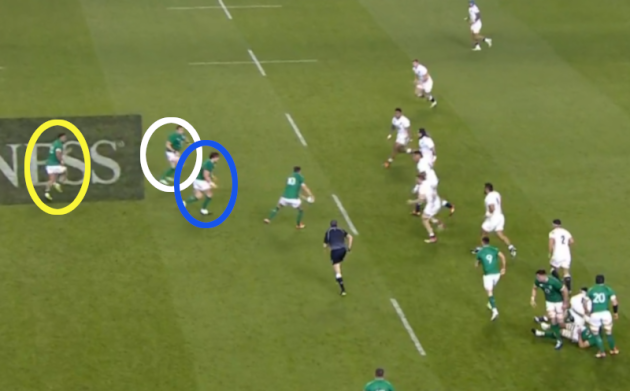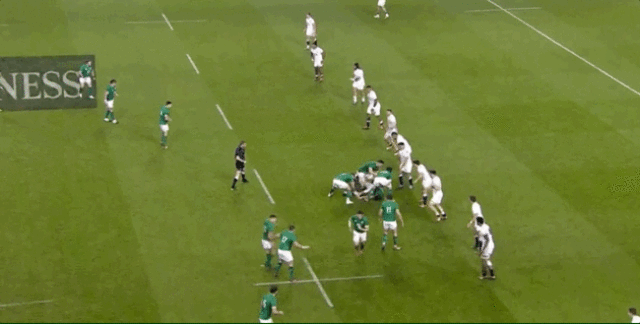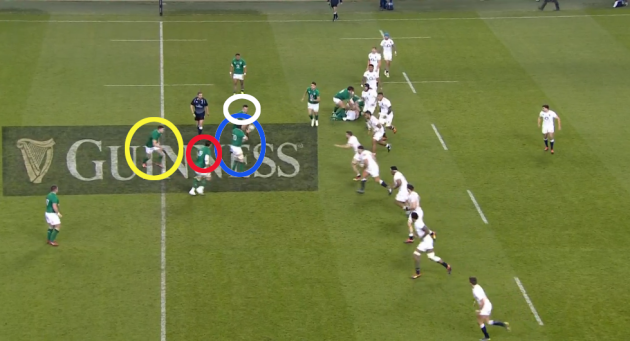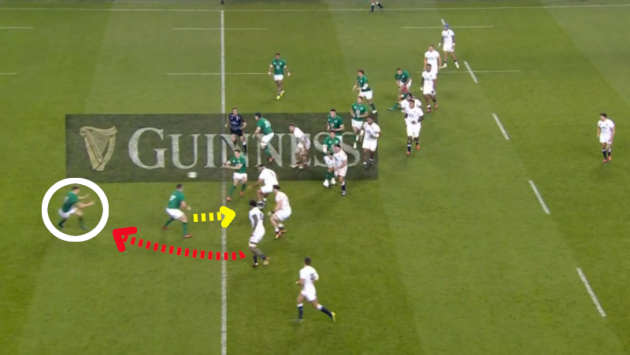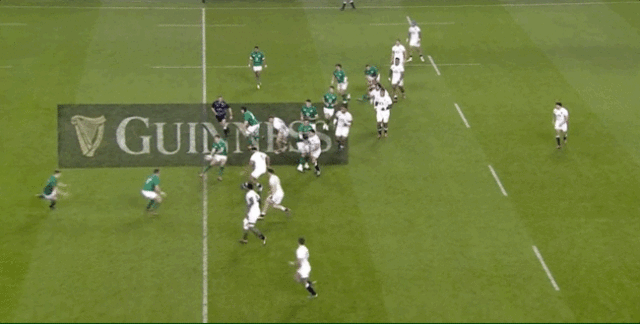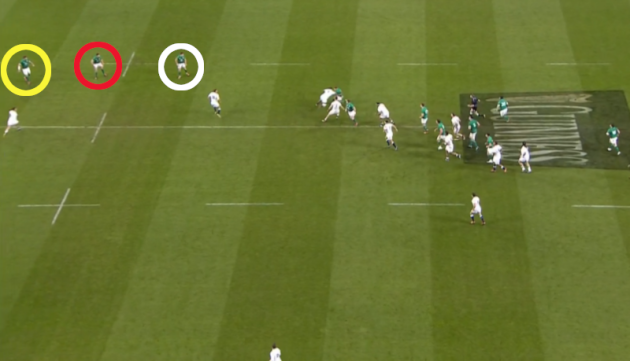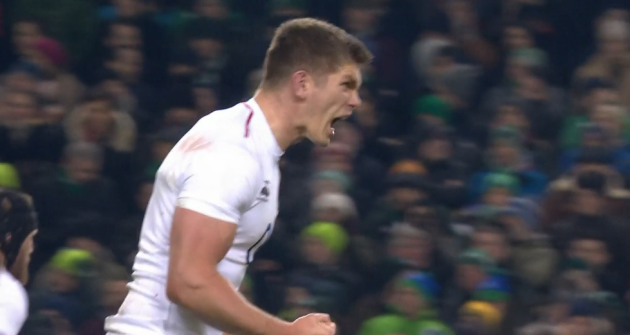IRELAND, JOE SCHMIDT admitted after Saturday’s defeat to England, had “over-played” in attack.
It’s a neat summation of how things went for Ireland, who had nearly 25 minutes of possession in the game but created very little of significance with ball in hand.
Ireland kicked 32 times, the same number as England, but the quality of their kicking was inferior to what the visitors brought with their ability to find grass and manipulate the Irish backfield.
Ireland struggled to get momentum into their attack, advancing over the gainline with only 45% of their carries compared to England’s 57%, but they persisted in running at Eddie Jones’ team to their detriment.
Despite the seemingly big issues in Ireland’s attack, they will – as ever – be focusing on small details in seeking improvement against Scotland this weekend in Edinburgh.
Ireland have major belief in their attacking approach and ability to break teams down and they will not be making philosophical or systematic shifts over the course of this week.
Instead, Schmidt will be highlighting to his players the opportunities they missed against England and how the seemingly minor details can make a major difference.
There were many examples of disappointing attack from Ireland on Saturday against England but this article focuses on two incidents.
The best opportunity of all
Soon after an Owen Farrell penalty miss has left Ireland trailing by just 17-13 in the 64th minute, Robbie Henshaw does superbly to retrieve a Conor Murray box kick on the right touchline.
Click here if you cannot view the clip above
Murray’s kick is heading for touch and out on the full, with England’s Jonny May happy to leave it do so, but Henshaw leaps to bat the ball infield and rescue his scrum-half.
The ball comes off Henry Slade and goes forward, with referee Jerome Garces indicating a knock-on advantage to Ireland.
More importantly, Ireland are suddenly into a turnover situation against an England defence that now has to organise itself rapidly. Dave Kilcoyne gathers and ploughs into the English half.
Murray quickly passes the ball left [indicated with a white arrow below] to Andrew Porter, who tips on a short pass to James Ryan. As Ryan receives the ball, there is plenty going on around the pitch.
Garry Ringrose [circled in white above] is setting up to act as the first receiver on the next phase, while Johnny Sexton outside him scans the pitch [red].
Sexton recognises that Nathan Hughes and Manu Tuilagi [both in yellow] are going to be isolated on the edge of England’s defensive line on the next phase.
England right wing Jack Nowell [circled in blue] is in position to join them if Ireland attack wide, but the rest of the English back three is disorganised.
Fullback Elliot Daly [green] is still on England’s left after the aerial loss, while May is off screen, having just set off into the backfield to provide cover there.
All in all, England are in poor defensive shape and Sexton believes Ireland have a chance to break wide on the left.
While Ryan is making his carry, Sexton is organising the players just outside him – Bundee Aki and Josh van der Flier. We don’t know the exact wording, but Sexton calls for van der Flier to run a hard line to his left, in front of Aki.
As Murray gets set to launch the next phase, Ireland seem to be in good shape…
Ringrose [green] is set up at first receiver, while Sexton outside him continues to scan [red], having communicated his call into Ringrose too.
Robbie Henshaw [blue] is working across to add another attacking number out on the left, while van der Flier [yellow] seems set up to run hard off Sexton.
Aki [white], is the key point of interest here, though, as we can see him beckoning to van der Flier to get wider and deeper, allowing him to arrive on a decoy line off Sexton more ideally.
But there has been a breakdown in communication and van der Flier advances up beyond Sexton to run his decoy line off Ringrose instead.
Van der Flier has already gone beyond Sexton above, meaning that when Ringrose receives the ball and turns his head, he sees a different picture to the one he expected based on Sexton’s call…
Ringrose doesn’t expect to see van der Flier this high up the pitch, with Sexton’s call having encouraged the centre simply to pass directly to his out-half.
Tuilagi has begun to shoot up from the England defence [indicated in white] in response to van der Flier’s line and Ringrose suddenly feels the pass to Sexton is not on.
The shot above finally allows us to appreciate how good an opportunity Ireland have out on the left here, with Jacob Stockdale [blue] and Jordan Larmour [red] lying in wait – two players who are lethal in space.
In the split second he has available to him, Ringrose decides to keep the ball and carry [green below].
As he does so, we can see the exasperation from Sexton [red] at a missed opportunity, the out-half’s hands in front of him in that characteristic fashion of his.
Making the frustration worse is the fact that Ringrose loses the ball forward as he carries, with the excellent Mark Wilson cleverly using his right hand to strike it loose while he dives to tackle.
With Ireland having burst into the England half after Slade’s knock-on, Garces has already deemed their advantage over – a little early, perhaps – and he awards a scrum to the visitors.
Sexton’s reaction is instructive here, as he focuses his annoyance on van der Flier rather than Ringrose.
“Josh,” shouts Sexton to attract the flanker’s attention.
Sexton, presumably, explains to van der Flier what his call was…
It seems that van der Flier’s reaction is something along the lines of, “I did run that,” which sees Sexton respond with, “[Run it] Off me!”
The point of focusing on this exchange is not to criticise van der Flier, but rather to highlight how one minor detail going wrong can be so costly when attacking opportunity beckons.
Van der Flier clearly heard Sexton telling him which kind of line to run – hard, against the grain and designed to tie down defenders as Ireland went out the back door – but he believed he needed to do so off Ringrose rather than Sexton himself.
What is very clear is that Ireland had a major opportunity wide on the left here with Larmour and Stockdale in space, while Aki and Henshaw worked outside Sexton.
Perhaps this failure points to a bigger issue – Ireland being dependent on structure even in a turnover situation where they have clear space to attack to – but that’s not what Schmidt’s team will be focusing on.
For them, getting the small details right will have a big effect on their attack.
This miss proves to be extremely costly, as England score a try directly from the ensuing scrum through Henry Slade to move into a 13-22 lead.
Forcing the issue
Still, Ireland wouldn’t have felt the game was gone yet, with 13 minutes remaining as they restarted through Sexton.
However, another failure in attack would prove to realistically extinguish any hopes they had of a comeback.
Stockdale fields Ben Youngs’ exiting box kick after the restart to launch another Ireland attack against the sublime English defence.
On sixth phase, Murray hits one of Ireland’s familiar three-man pods to the left of a ruck…
Quinn Roux [red above] receives the ball from Murray at the centre of the pod, with Sean O’Brien [blue] to his inside and James Ryan [white] offering support outside.
Sexton [yellow] is in behind the pod as a back-door option. While he has his hands in front of him, the out-half is not a convincing possible receiver of a pullback pass from Roux in this instance.
It was a recurring issue for Ireland in attack against England. The backs in behind the three-man pods were often lacking in the kind of ‘animation’ – body language indicating the possibility of receiving the ball – Schmidt expects.
Indeed, sometimes backs weren’t even present in these positions. One of the effects of the poor work in behind these pods is that it made life much, much easier for the English defenders in getting real power into their tackles.
If players out the back of the carry or either side of it can add distraction – as England did well in the lead-up to Jonny May’s try – that can reduce the effectiveness of the tackle, with defenders having more options to consider.
This poor back-door work from Ireland played into England having 46 dominant tackles in the game, whereas Ireland had only nine.
After Roux carries in this instance, Sexton has a two-man pod outside him, as was so often the case in this game.
Andrew Porter [blue] and Sean Cronin [white] make up the two-man pod, with Aki [yellow] hovering out the back.
This simple shape provides Ireland with many options – Sexton can hit Porter short, pass wider to Cronin, get across Porter and pass to him on a switch line, dummy the switch to Porter and hit Cronin short, dummy the switch and short pass and pull the ball back to Aki behind Cronin, pass to Cronin for the hooker to slip the ball back to Aki, and so on.
Another option Ireland used frequently in this game was for Sexton to send a ‘tunnel’ or ‘needle’ ball in front of Porter and behind Cronin to Aki – although they were sometimes poor in their execution of this play, with Aki too deep on one occasion.
Here, however, Sexton opts to pass to Cronin for the hooker to carry, but the ball goes to ground.
Click here if you cannot view the clip above
For whatever reason, Cronin doesn’t seem to think the pass is intended for him and opts not to attempt to catch it.
Sexton shouts, “Nugget!” in annoyance, using Cronin’s nickname.
Again, the point here is not to criticise Cronin or Sexton in particular, but rather to highlight this breakdown in understanding and communication between Irish players in attack – a theme throughout this game.
Van der Flier does gather up the ball for Ireland here, but they’ve completely lost the momentum of their phase play and need to reset before looking to cut England.
Instead, Ireland react poorly to losing ground and momentum – attempting to shift the ball wide to the other side of the pitch on the very next phase.
O’Brien [blue] is now at the centre of the three-man pod as Ireland shift right, with Ryan [white] on his inside and Roux [red] outside him.
This time, Sexton [yellow] actually wants the ball and we can see the difference in his body language and movement. He’s animated and in motion because he has called for a pass from O’Brien.
The shot above also shows us that the English defence is in strong shape opposite Ireland, having had time to organise when the ball went to ground outside Cronin.
O’Brien swivels to pull the pass back to Sexton and the picture worsens for Ireland.
Sexton doesn’t have a two-man pod outside him on the second wave of the attack this time, with only Dave Kilcoyne [yellow] running short off him.
Sexton fires the pass out the back of Kilcoyne to Ringrose but, with England’s defence in such good shape, that’s simply an invitation for Courtney Lawes to shoot up out of the line and hammer Ringrose in the tackle.
Click here if you cannot view the clip above
England openside Tom Curry, coming forward to the tackle, doesn’t need a second invitation to jackal over the isolated Ireland centre and clamp onto the ball.
With Ringrose’s support in front of him and now forced to scurry backwards to resource the ruck, Garces awards Curry his deserved turnover penalty – created by the aggressive English defence.
When we view the play from behind England just as Lawes hits Ringrose, we can see that Ireland actually have three more players wide on their left in Stockdale [white], Henshaw [red] and O’Mahony [yellow].
The point is not that Ireland should have forced the ball straight to them on this phase, but rather they needed to be more patient in getting the ball to these numbers.
Having lost momentum and the gainline when Sexton’s pass to Cronin went to ground, patience was required from Ireland – perhaps a carry from O’Brien or a tip-on pass to Roux to carry to regather some momentum.
Even if Ireland hadn’t pushed back beyond the gainline, they could have deprived England’s defence of bodies and increased their own chances of getting the ball wide to the right on the next phase – or targeting space in England’s backfield with a kick.
Instead, Ireland forced the issue and gave up the penalty that allowed Farrell to kick England 25-13 in front with just 10 minutes remaining.
This example is symbolic of how much of Ireland’s attacking went on Saturday – the loss of gainline followed by Schmidt’s men still attempting to create an opening with poor possession.
Only early in the second half did Ireland actively pursue a short kicking game and even in those efforts, their lack of cohesion and accuracy in the small details let them down.
For Schmidt, those little details are always the focus.
- Originally published at 07.00
Subscribe to our new podcast, The42 Rugby Weekly, here:
